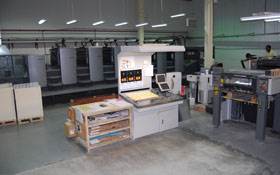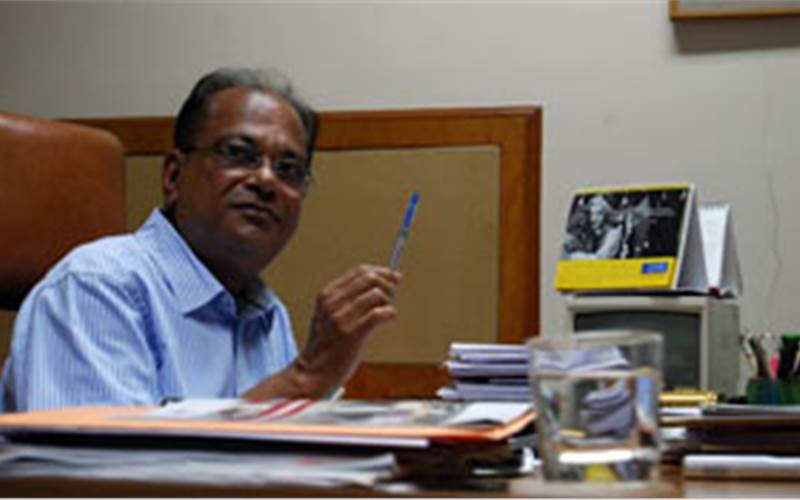The unique tale of Ashok Nerker - in India and the Middle East
Ashok Nerker, owner of Unique Photo Offset and Gulf Scan talks to Ramu Ramanathan about the trends in the print market of Mumbai and Sharjah.
21 Aug 2010 | By Samir Lukka
Ramu Ramanathan (RR): It is quite extraordinary what you have created in Sharjah with Gulf Scan. The unit offers artwork creation, digital imaging, sheetfed offset, narrow web flexo and gravure cylinders.
Ashok Nerker (AN): Yes, the news from the Gulf Scan unit is promising, with a noticeable improvement across a number of fronts. The economy is growing again, prices have recovered, credit has improved, and corporate confidence has increased. Print activity has increased 10% year-over-year. However, one has to be cautious, that we do not go back to the slowdown days. Macro-economic questions remain regarding debt, growth rates, and the outlook for the Middle East economy.
RR: One of the thing that emerges is how at Gulf Scan you have continued to create value by consolidating on multiple industry segments.
AN: I believe that the printing business requires very close supervision. One must know all the facets like costing, estimation, production, customer management. In fact everything. Unlike large companies the printing industry cannot afford to have large number of corporate managers. However scalability still remains a valid question in this industry.
RR: Is it because print has become a totally competitive market?
AN: No, I'm talking about scalability. You have to use the same amount of energy or intellectual capacity to make a decision worth Rs 500 crore or Rs five crore.
RR: Do you feel you've have achieved that scalability in Gulf Scan?
AN: No. In the printing industry there will always be a limit on size and turnover.
RR: What about some of the giants of printing and publishing? Would you combine printing and publishing?
AN: In publishing the sheer volume is larger. India Today, is at the size it is, because of publishing and the advertising revenue. The printing component gives the added advantage of having the facility in-house which is convenient and economical.
RR: In that sense have you been disappointed with digital?
AN: Basically, if you look at variable data, digital is the right choice. It is suitable for smaller runs.
RR: And so, what is your USP?
AN: Our focus is on packaging. We have extremely valuable clients who appreciate our knowledge and level of service. Their jobs are the ones that thankfully keep us in business! Our USP lies in the building and nurturing of long term relationships with these clients.
RR: But you have invested in digital for your OOH work at the Mumbai unit?
AN: We have customers with all sorts of requirements from offset to flexo to outdoor – specially for their advertising needs. We took a conscious decision as an organisation, both in Mumbai and the Gulf to make sure we cater to all their needs.
RR: There are companies like Kris or SGRE who have a combination of technologies and that they've added an Indigo for label printing. They use it for proofing or short-runs.
AN: That's true. But when you say digital as a proofing solution, then you are restricted by the number of colours. Plus, you cannot attach online finishing or other solutions. And so even if you proof, it is a prohibitive cost. And the speed you are talking about is very slow. But it's a matter of opinion, I do believe that some firms find it economically viable to do proofing or short runs.
RR: In a sense, are you content with the transition that Unique has made from a traditional pre-pres house into what you've created with Gulf Scan?
AN: We made a need based transition because of the precarious market. Also with the added technology change we had to create a new direction and have multiple revenue streams.
RR: 2007 was a very tricky period for pre-press – and for business.
AN: We took to printing much earlier in the Gulf, but at least the direction was pure print. We had to take a conscious decision; and we zeroed in on gravure. We asked ourselves: what do we know? We know offset printing. Gravure we were doing. So then, why not do something that we know, rather than re-learn everything.

A section of the offset unit at Gulf Scan
RR: Unique was one of the big three in Mumbai in terms of pre-press along with Comart and Jasra. Was it tough to let go of the core competency?
AN: The core competency is still there. A company's biggest asset is its knowledge base. Pre-press knowledge is still required for offset, flexo and gravure. We have just given a different spin to it to suit our needs. Shifting direction to create a newer market for us but at the same time not entirely letting go of what we know best.
RR: Also pre-press technology has been democratised....
AN: Yes. Pre-press technology has become easier and an open platform which is good.
RR: Therefore for flexography, what advice do you have? Because we're suddenly finding a lot of investments happening in that segment. Pre-press for flexo again is a weak and dodgy area. Traditionally print firms depend on a Color Dots or a Numex of Vee Pee. So what advice would you have to give in terms of pre-press?
AN: It is good that the companies you mentioned are able to offer valuable service to flexo printers. But like pre-press, flexo plate making will also become easier in the time to come and will move into the printing press.
RR: It's quite complicated. Flexo is really complicated.
AN: Most complicated printing process, if you ask me.
RR: How? Because earlier you mentioned the lack of standards. For instance if you go to the ISO website and click on offset or digital, there are standards. If you go to flexo, they say work in progress. What is the reason for that?
AN: In offset printing the standards were made specially for publication printing and that also for process colors on different papers. There is not much publication printing by flexo. Also with the anilox roller in flexo and the variable cell depth and cell volume in gravure, standardization may not be required. The standards are in the pre-press part of flexo and gravure.
RR: Does lpi play as much of a role in flexo? I mean, do you have customers who demand 175 to 200 lpi?
AN: Not really. There is no demand or requirement specifically for high definition. We provide it anyways.
RR: Mr Nerker, for me you are one of the masters of colour. I've sat on the systems at Unique and done de-saturation and colour retouching. Do you still look into each and every job? I recall you looking at my positives and then throwing people out of this same cabin.
AN: (laughs) I don't throw people out. In Gulf Scan that's not possible because of the scale of operations.
RR: Yes, it's massive. You have 125,000 sqft. Of which 75,000 sqft is just the ground floor. The other two floors are about 35,000 sqft. Plus a staff housing complex for more than 80 staffers. How did it begin?
AN: For this, you need to go 20 years back and what triggered it. There was a time when we wanted to benchmark our knowledge and skill sets against a global environment. India was a different place at the time so the UAE provided us an opportunity to venture forward. Allowing us to move from a national to a global level.
RR: And today, you have succeeded.
AN: What I'm very proud about is, leaving the commercial aspect aside but my people, my team who have contributed and have grown with the company from scratch, they are able to have a better quality and standard of life for themselves and the most importantly their families. The Gulf has provided their children opportunities that would not be possible. It makes me happy to know that I played a part in this process.
RR: Are you sort of surprised at the kind of market domination you have in that area, it's huge.
AN: Yes. We had especially in gravure cylinders a hundred percent market domination at one time,. This was five years ago but now there are new players and competition keeps things healthy.
RR: Another I recall from my visit to Gulf Scan is, the work ethics of your staff is much higher and improved.
AN: Yes. It's more professional. We have the opportunity to employ a variety of nationalities. Being in the Gulf, they (clients) expect a global standard of service and we expect that from our employees. Demographically on the workers front, the office staff front, we have a mix of Indians, Philipinos, Nepalis, Sri Lankans and Bangladeshis.
RR: It sounds like a mini United Nations.
AN: True. Nowadays, everybody goes the Middle East to work and earn money. So the entire composition of their mind is very different. Naturally the environment makes you more competitive and drives them to put in their best. They are intellectually more honest about their job. Discipline-wise, it's much better.
RR: And the combination is still this? 40% gravure, 40% offset and 20% flexo in terms of the breakup?
AN: Yes.
RR: That's a good note to sign off. Always a pleasure to chat with you Nerker. I want to do a workshop with you on the do's and don'ts of colour whenever you've time. As long as you promise you won't throw me out of your cabin.
AN: You are most welcome!
Photo Gallery
Ashok Nerker (r) with his son Gautam (l) in front of the Omet narrow web flexo machine in Mumbai
Gautam Nerker at the OOH setup in Mumbai
Gulf Scan
Other Q&A sessions with:
Pratap Kamat of Uma Offset
Ashwani Bharadwaj of Micro Inks
Pranav Parikh of TechNova
















 See All
See All